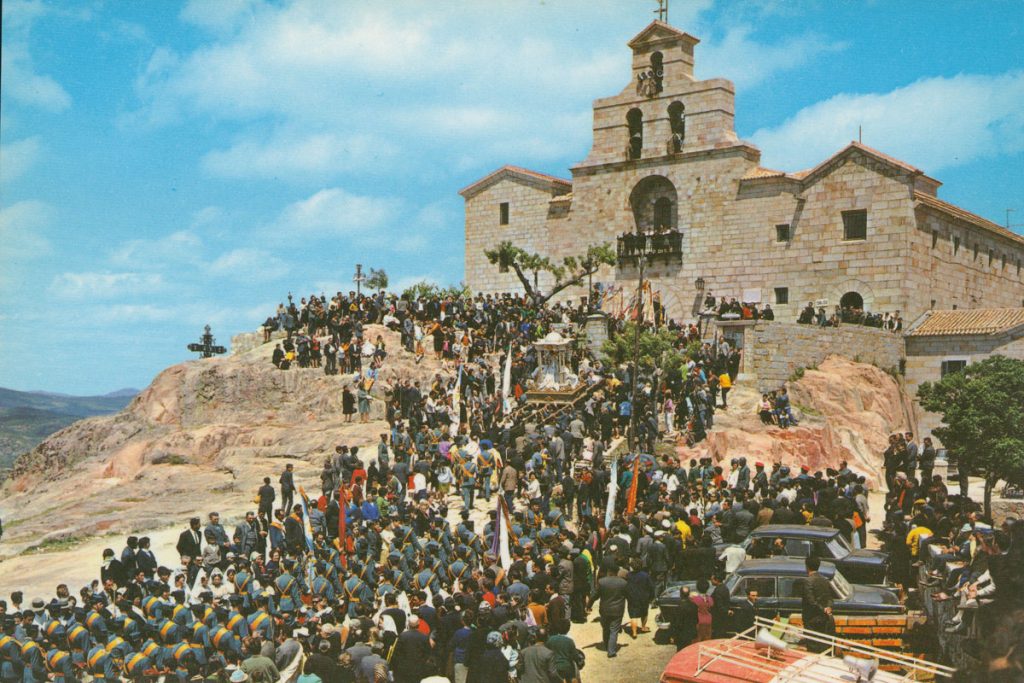According to tradition, in August 1227, a pastor of Colomera (Granada) is an image of the Virgin of the Head in the heart of the Sierra Morena, within the city of Andújar (Jaén). This fact is considered by others as appearance.
The castle of Andújar had been delivered by the arabs, in particular by the-Bayasí, the king Ferdinand III in 1225, by a pact signed between the two, which included a number of other localities of the province of Jaén.
Note also that in the SEVENTEENTH century it was believed that the appearance was in 1233, being disregarded, without further explanation, leaving as the ultimate bliss in the beginning. In the book Atlante Spanish, Bernardo Spinal, published in 1775, places the date of the apparition of the Virgin January 16, 1227. In principle, this can be one of the many errors that the author commits on Andújar, as with other locations, not to be that this is the key to understanding, as we will see later, why it is said that the pilgrimage changed month.

We must also inquire about the day in which we traditionally commemorate, from the early TWENTIETH century, the singular event of the call appearance of this Lady. All of the authors that we know from the SEVENTEENTH century until the end of the NINETEENTH century, did not indicate in no time, just point to the mentioned August. But in 1890 it will be known that it was on the 12th of that month.
The reason of such date could not relate to the 12 Apostles, the 12 Tribes of Israel, or of the proximity of the date to the day of the Assumption of Our Lady, on the 15th of August, the day that is dedicated to the sanctuary of the Sierra Morena.
It was not until 1918 when they commemorate the feast agosteña, with a mass at the parish of St. Mary Major. From then until now; but after the Civil War moved to the night of 11 to 12, but in the aforementioned sanctuary.
Currently the guilds gather around the Virgin of the Head to hold a series of acts, such as: Holy Rosary, presentation of fruits, offerings and flowers of different guilds, holy mass in the open air, a solemn procession of the Virgin by the causeways of the sanctuary, and finally besamanto. All this lasts until the wee hours of the morning.
The Legend
The legend that we know of, written, on the origin of Ntra. Lady of the Head, it comes from the SEVENTEENTH century. He tells us this, from San Eufrasio, -considered the first bishop of Iliturgi; ancient iberian settlement romano, located near Andújar, in Los Villares, today proved that it is Isturgi, since in Mengibar (Jaén) is Iliturgi, which evangelized this area, being one of seven Male Apostolic came to Spain. To this saint today patron saint of the city, was given a picture of the Virgin by St. Peter, made by St. Luke, and that was hidden in the sierra before the arab invasion. Past five centuries, it appears to be a pastor, who calls out to the town of Andújar, and tell its people to build in that place a temple, and for that you believe will sound an arm that had prevented from moving. Known the message and accepted the fact, is organized the way of bringing the image of the sierra, to be deposited in the church of Santa Maria. Once at the villa, we performed several miracles, but the Lady vanishes and is found again in the place of its appearance or discovery, so that the people understand that there is where he must build his home and not in another place as it had started, next to the river Jándula.

The legend includes a series of dialogues between the Virgin and the pastor. The first miracle was the cure to this arm, as discussed earlier. Who writes the legend, not particular if was maimed, that is to say, he lacked, in whole or in part, or had an immobility of the same. After recovering its upper extremity, the pastor checks that had not been all a dream, and up to Andújar; but leave there the image of the Virgin, instead of taking her with him, as perhaps it would be more logical. But the author of the legend doesn't think that way, because the divine mandate, it would be easier to comply; since the temple was to be built just where he wanted, to do this I had to get the pastor to the people outside that place, so that all would know and his credibility would increase, finding it to turn.
Many of the assertions about the origin of the image are made, are based on the cronicones Flavio Dextro that are considered to be false, as claimed by the priest Manuel Muñoz Garnica in the NINETEENTH century when it raises a lot of doubt about this Lady, not accepting the legend and not understanding how in those years, even someone I could continue believing it.
The legend about the Lady of the Head has a christian origin, for the countless elements that are present, as is customary in the biblical tradition. The pastor is presented as a new Moses who, following the light goes up to the mountain, in which he hears a bell, and in a hollow of the rocks is the image of the Virgin.
It should be noted that in other places where they are worshiped Ntra. Lady of the Head, the legends that speak of their origin, have points in common with that of the Sierra Morena, in particular with those of Zujar and the Zalabí Valley in the province of Granada.

